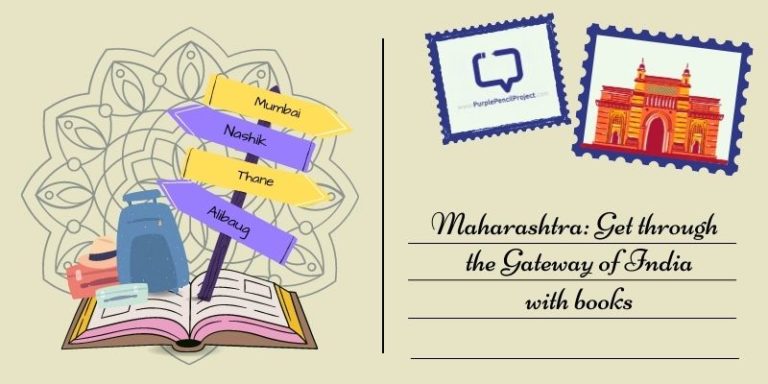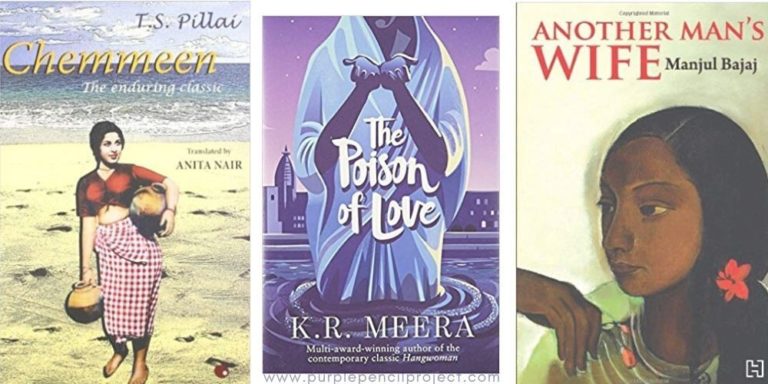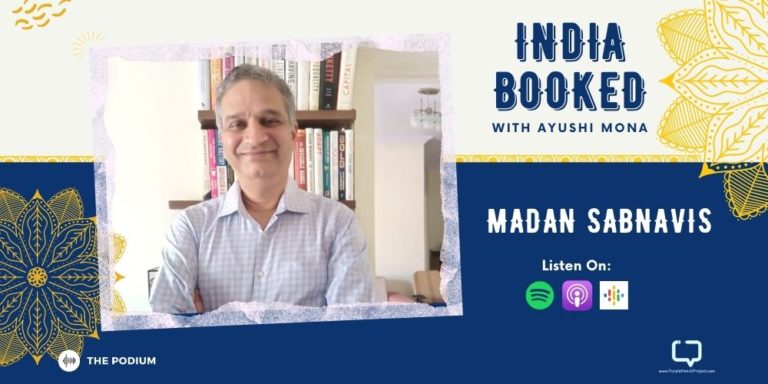Archana Mirajkar is a communication specialist, author, and translator from Marathi to English. Her original play ‘Hello, Kon?’ was critically acclaimed. Her latest book, ‘All the way…Home’, written in English, is a science fiction. She was a speaker at the Jaipur Literature Festival 2022. Edited excerpts from a video interview:
Prakruti Maniar: Thank you for speaking with Purple Pencil Project, which is a venture to bring Indian Literature on one digital community space. How is it to be part of Jaipur Literature Festival?
Archana Mirajkar: Thank you for having me, Prakruti. And I really appreciate what you’re doing. Because, you know, that is the ethos of India. We’re so versatile, so diverse, and yet we are one country. So, I think, that the work that you’re doing, just exploring what all is there in different languages, is absolutely fantastic. It’s such a great celebration of literature, of ideas, music, dance, all the creative forces. And this is, I think, the epitome of being human. We see, all around us, so many negative things happening, so much reaction happening with polarization.
But when it comes to literature, when it comes to new ideas, we are creating, we are exchanging with each other, we want to be curious about knowing about each other. And that’s what literature does, you know, building bridges. So this festival, which gives a platform for doing just that for several days, is a such a wonderful opportunity.
We encourage you to buy books from a local bookstore. If that is not possible, please use the links on the page and support us. Thank you.
Prakruti Maniar: As a writer of the Marathi Language, do you sometimes feel that your audience is limited, the stage smaller? How does translations help in that?
Archana Mirajkar: Yeah, I do think that, you know, the flip side of writing in a particular language of India is that your readers are limited. Sometimes, if you’re a writer of a particular language, you tend to focus on the literature that has been produced in it. However, now, I think, although at a slower pace, translations are taking place and you know, Sahitya Academy plays a major part in that.
Prakruti Maniar: …and we are multingual in our everyday life too, but the internet tends to be so monolingual…
Archana Mirajkar: Exactly. Most Indians are bilingual or trilingual. One is of course, my mother tongue, the reason that I was born from (it). By education, both of us are educated in English. So, we are acquainted with English literature. But there is always, possibly, a third language. Like I am fluent in Hindi, I can understand Punjabi, I can understand a little bit of Gujarati. But we don’t tend to go beyond our comfort zone to read literature in that language.
And, I think, that translation is something that is able to pave the way to send out literature from one language to another. And I think the publishers should do the same, because it’s not about the economics (of it) too. One particular language is not looking beyond that particular language. But there should be a consortium of publishers from different languages or clusters of languages where they actively translate from one language to another. And that’s the only way we’re going to know the literature of one region from another region.
I’ve done a lot of translation. I have translated Indira Goswami into Marathi which was very well received. Her biography, that was the first book, I calculated, had multiple editions, because people were so fascinated by the ideas and themes that she was introducing to the Marathi speaker, so that’s one aspect. But there are also, now, departments of comparative Indian literature in Jadavpur University, Delhi University and other universities that are also conducting courses in that and that is something that is introducing students to Indian literature as such. Because there is the concept that Indian literature, as such, has so many commonalities as Indian culture.
Archana Mirajkar: So, I absolutely agree with you that (the) internet is mostly a monolingual space. Normally we would talk with each other in one of the many Indian anguages. When you get online, you tend to type in just one English. And that’s also true for most of the social media platforms. All social media profiles, especially Facebook, provide you the option of choosing your own language, like Marathi. (Many in) the older generation, they tend to use it too, even authors. There are some groups on Facebook, (some of) which are literary groups (too), they tend to definitely engage with readers in their regional language. There are Facebook lives, there are webinars that are conducted in it. But it is a limited effort within those circles, who are either writers or some kind of professors or critics in that particular language.
There has to be a proactive effort now, especially after the digital turn of the COVID-19 pandemic. I started my YouTube channel Granthyatra during the lockdown. I couldn’t find anything that was engaging enough or that had content that was worth my attention, you know, beyond a particular point. In it, I’m introducing Marathi literature through 100 books, and I deliberately did publish these episodes in Marathi as well as in English, because my own attempt is not (towards) Marathi readers, or the literature of that particular language. (…) Now some of my viewers would come back to me and say, Why don’t we do this in Hindi? It’s difficult because there’s a lot of work involved in producing an entire episode in one more language than it was originally designed for.
So these kinds of efforts, done at an individual level, remain limited, but I do feel that you know, as organizations, as people of India, we should proactively have platforms where these kinds of interaction will go beyond the boundaries of language.
Prakruti: You said Marathi to Hindi – what are the difficulties or nuances of translating between one Indian language to another, surpassing English?
Archana Mirajkar: I would say there are both pros and cons. I was always educated in English medium from the beginning. So it comes very naturally to me, and as you’re sometimes trying to think in terms of the syntax of English sentences. However, there is also a positive side because, especially for Hindi and Marathi, they’re very close languages. From the linguistic point of view, the sentence structure is similar. But also from the cultural point of view, because there are too many nuances, you know, which are very typical to India. And those are either expressed in English or translated, some of the finer qualities are lost there, because we’re trying to interpret a particular cultural phenomenon to an alien audience, there are alien readers there. So you’re trying to transform it when you are translating into English first, whereas if you’re just picking it up from an original Indian language and just putting it into another Indian language, sometimes it becomes much, much easier.
Just take an example of, you know, the grinding beans. In olden days, when the flowers used to be ground at home and women used to mill the wheat at home, those beans, I think, (are) universal across India, so I don’t need to translate it or give another description of what it is. It’s very easy, I can pick it up from Hindi and put it but that’s just an example.
But English does a fantastic job of being a facilitator language. Sometimes a book from one language gets translated into English and then from English into another Indian language. So it acts as a kind of a (tool for) building bridges across cultures.
Prakruti Maniar: You do not stay in Maharashtra, so how do you keep in touch with Marathi language and literature?

Archana Mirajkar: In Marathi, we have some wonderful literary magazines, still functional. There were many that used to be published and subsequently closed down because of the economy, or lack of readers, or the digital turn. But there are still not just a couple, but a handful, of literary magazines. So Lalit, this is one very, very prominent magazine dedicated mostly to literature, where you get introductions to new books, advertisements, and reviews of new books are also there. There’s another magazine called Sadhana which is not just a literary magazine, it’s covers contemporary issues, but a major portion of it is devoted to literature, where again, you get reviews on books. There is Panchdhara. That is also, again, not exclusively a literary magazine. But again, a lot of literary books are introduced there. There is Akshar Wangmay. Again, another very wonderful magazine. It’s not a monthly, it’s a quarterly, but a very substantial portion of it is devoted to literature. These are regular magazines that one goes through, to understand the trends in Marathi literature or get to know of new books.
There are other groups, online groups also, one is called वाचनवेडा, (where members are) crazy about reading. Members talk about the books they are reading and several new books get introduced here. These are some of the avenues from where you get to know what’s happening. A lot of the contemporary trends that I was talking about in Marathi literature, a lot of new ideas are taking place. Nanda Khare, one of the contemporary writers who recently won Sahitya Academy award, his novel Udyā, which means tomorrow, again, talks about the social media, the connected world, and how interpersonal relationships are being lost in that. There are a lot of very powerful feminist writers, poets, who are writing about the new woman, and her dilemmas. All these trends are taking place, so I would say the present Marathi writers are very much in line with what’s happening around them. A lot of writers are writing science fiction too.
Prakruti Maniar: That’s interesting. My sense is that science fiction is rather underexplored in the literature of non-English languages…
Archana Mirajkar: In Marathi, there’s Narlikar, who is a very well known astrophysicist, he happens to be Maharashtrian. And he was, we could say, a pioneer of science fiction writing in Marathi. He has written hundreds of science fiction short stories, (and) several collections (of them) have been published now. And he was very instrumental in popularizing science to the common reader. Otherwise, especially when he started writing in (the) early 50s and 60s, there was this clear divide in that generation. People were either science oriented, or they were humanities oriented, but he’s writing about these scientific phenomena in a very attractive form of science fiction to the Indian audience. And then subsequently, taking inspiration from him, there have been several good science fiction writers in Marathi, like Baal Phondke. There have also been writers who’re on the borderline of fantasy, horror, and science fiction, all of that, but now the new generation is coming up. And in fact, there’s a huge demand for science fiction workshops that colleges conduct. And a lot of people are interested in that, even small colleges in Aurangabad, in smaller towns like Nasik, have these workshops to talk about the craft.
AP Deshpande, he’s another writer. Marathi Vidnyan Parishad, which is the body that popularizes science among lay persons, they are taking the initiative of publishing science fiction stories of and by Indian writers, not just Marathi, and a new collection is about to be released. I’m guilty there because I wrote one novel, it is a science fiction, but I wrote it in English. I write in both languages, but unfortunately, I have written my science fiction in English.
Prakruti Maniar: So how did you decide that your science fiction story will be in English? How do you decide which language to explore an idea in?
Archana Mirajkar: Okay. So even I don’t understand how this mechanism works in the brain. But sometimes when an idea comes for writing, it comes in that particular language. And I feel it’s natural to develop it in that particular language instead of forcing it into another, another kind of menu in your brain. So when I was writing the science fiction (book), I’ve said this before, but, very ironically, it came to me in a hospital. I was admitted for some ailment in a hospital and I was lying there on the bed. And suddenly this spark came to me; I requested my father to get my laptop and I started writing it then and there. But, I don’t know, maybe because it was so scientific and I read a lot of popular science, you know, the astrophysicist Brian Greene, Carl Sagan and Michio Kaku and all these, Roger Penrose, these are my favorite writers, because I’m very passionate about astrophysics. And because, I think, they are the ones who are looking at some fundamental questions of human existence and trying to find answers to them quantum mechanics and the universe, the fundamental research that is taking place just to understand reality, the nature of reality is very fascinating for me. I read a lot of their writing. And maybe because of that, when this idea of the story came to me, it came to me in English, and when I started developing it, (it) automatically translated into English.
But in contrast, my other book, which is my recent book, it’s called Swayamsiddha, is about five rebellious women from Mahabharata. And it’s their stories reimagined. And that came to me in Marathi! And I’ve been writing these stories, the book is recent, but I’ve been writing these stories for the last 17 years. And the first story came to me on Hidimba. I was visiting Manali. You might know that Manali has a temple of Hidimba, because Hidimba was originally from Manali. So when I visited there 17 years ago, I had written this short story. And it was a smaller story then and later on, I developed it, and that’s how the thread began. And from Hidimba, it went to Rukmini and then I started thinking about a book. So when I was writing about these women, they kind of possessed me. I could think of nothing else. When I was writing Hidimba, she was kind of inside me and all the time I used to just think that. (Whether) I was driving to the office or doing household chores, she would preoccupy my mind. And I would just be thinking about that. And then I wrote Rukmini, another story, similarly. Then this thread came to me that perhaps what I’m writing about are rebellious women in Mahabharata who save their own destiny through their own actions or decisions, and then I had to decide who are the others.
And then Chitralekha came to my mind, Ulupi came to my mind. So I was going to sit down and write about Citra later when Kunti pushed herself inside. Because these are all supposed to be love stories and Kunti’s is not a love story but she did something very, very drastic that probably shaped the entire Mahabharata. And she just pushed through and I had to write about that. But now I have read a lot about it, right from the original Mahabharata to others. Irawati Karve is one of the very prominent writers in Marathi, she’s written on Mahabharata. There are wonderful novels like Karna, or Shivaji Sawant’s novel. There’s a tradition of writing on Mahabharata and because I’ve read it all in Marathi, probably the stories got developed in my brain again in Marathi. So, the ideas originally come in that language and then get developed into that language.
Prakruti Maniar: So who are other writers who have influenced Archana Mirajkar?
Archana Mirajkar: If I have to talk about the influences on me, I would start from the Bhakti literature in Marathi, it had the same voices, starting from the 13th century (and) going right up to the 17th century, Maharashtra has a rich tradition of Bhakti literature. Saint Namdev, Saint Tukaram, Saint Eknath (…), they’ve written beautifully and what they have written is still relatable. When we are in an existential crisis, when we are surrounded by global problems, like a pandemic or economic downturn, these fundamental truths are still applicable. They told us how to relate to these problems, how to find our own way through these problems.
They provide a beautiful foundation to our development as human beings and as writers; so those were big influences. Then there were the progressive thinkers and writers later on, right from Laxmi Bahia, who was one of the first women writers in Marathi. Contemporary writers who’ve contributed to the feminist movement in Maharashtra are the likes of Gauri Deshpande – they blew up when we were studying literature. Those were the writers that we studied and very (much) influenced me (with their) very independent thinking and they taught me how to question everything and take nothing for granted.





















